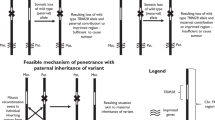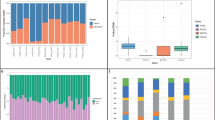Abstract
Wilms' tumour (WT) Is one of the most common solid tumours of childhood, occurring in 1 in 10,000 children and accounting for 8% of childhood cancers. It is believed to result from malignant transformation of abnormally persistent renal stem cells (nephrogenic rests) which retain embryonic differentiation potential1. Although WT is usually sporadic, approximately one percent occur in families in which susceptibility appears to be inherited as an autosomal dominant trait with incomplete penetrance1. Predisposition to other cancers or to the developmental abnormalities associated with sporadic WT is not usually apparent in WT families. The WT1 gene at 11p13 (ref. 2), and additional genes on chromosomes 11p15 (ref. 3) and 16q (ref. 4) have been implicated in the development of WT but are not responsible for familial WT5–8. We have carried out a genome linkage search in a large Canadian family with seven confirmed cases of WT. Our results provide strong evidence for the localisation of a familial WT predisposition gene, FWT1, to an 18-centi-morgan (cM) interval on chromosome 17q12–q21.
This is a preview of subscription content, access via your institution
Access options
Subscribe to this journal
Receive 12 print issues and online access
$209.00 per year
only $17.42 per issue
Buy this article
- Purchase on Springer Link
- Instant access to full article PDF
Prices may be subject to local taxes which are calculated during checkout
Similar content being viewed by others
References
Breslow, N.E. & Beckwith, J.R. Epidemiological features of Wilms' Tumor: Results of the national Wilms' tumor study. J. Natl. Cancer Inst. 68, 429–436 (1982).
Call, K.M. et al. Description and characterisation of a zinc finger polypeptide at the human chromosome 11 Wilms' tumor locus. Cell 60, 509–520 (1990).
Koufos, A. et al. Familial Wiedemann-Beckwith syndrome and a second Wilms' tumor locus both map to 11p15.5. Am. J. Hum. Genet. 44, 711–719 (1989).
Maw, M. et al. A third Wilms' tumor locus on chromosome 16q. Cancer Res. 52, 3094–3098 (1992).
Huff, V. et al. Lack of linkage of familial Wilms' tumor to chromosomal band 11 p13. Nature 336, 377–378 (1988)
Grundy, P. et al. Familial predisposition to Wilms' tumour does not map to the short arm of chromosome 11. Nature 336, 374–376 (1988).
Schwartz, C.E. et al. Familial predisposition to Wilms' tumor does not segregate with the WT1 gene. Genomics 10, 927–930 (1991).
Huff, V. et al. Nonlinkage of 16q markers to familial predisposition to Wilms' Tumor. Cancer Res. 52, 6117–6120 (1992)
Baird, P.N. et al. Identification of mutations in the WT1 gene in tumours from patients with the WAGR syndrome. Oncogene 7, 2141–2149 (1992)
Little, M.H. et al. Evidence that WT1 mutations in Denys-Drash syndrome patients may act in a dominant-negative fashion. Hum. Mol. Genet. 2, 259–264 (1993)
Pelletier, J. et al. WT1 mutations contribute to abnormal genital system development and hereditary Wilms' tumour. Nature 353, 431–434 (1991).
Wadey, R.B. et al. Loss of heterozygosity in Wilms' tumor involves two distinct regions of chromosome 11. Oncogene 5, 901–907 (1990).
Stay, E.J. & Vawter, G. The relationship between nephroblastoma and neurofibromatosis. Cancer 39, 2550–2555 (1977)
Szabo, J. et al. Hereditary hyperparathyroidism-jaw tumor syndrome; the endocrine tumor gene HRPT2 maps to chromosome 1q21–q31. Am. J. Hum. Genet. 56, 944–950 (1995)
Pilia, G. et al. Mutations in GPC3, a glypican gene, cause the Simpson-Golabi-Behmel overgrowth syndrome. Nature Genet. 12, 241–247. (1996).
Hartley, A.L. et al. Wilms' tumour in the Li-Fraumeni cancer family syndrome. Cancer Genet. Cytogenet. 67, 133–135 (1993).
Narod, S. Genetics of breast and ovarian cancer. B. Med. Bull. 50, 656–676 (1994)
Cairney, A., Andrews, M., Greenberg, M., Smith, D. & Weksberg, R. Wilms' tumour in three patients with Bloom syndrome. J. Pediatr. 111, 414–416 (1990).
Ellis, N. et al. The Bloom's syndrome gene product is homologous to RecQ helicases. Cell 83, 655–666 (1995).
Neri, G., Martini-Neri, M.E., Katz, B. & Opitz, J.M., Perlman syndrome: familial renal dysplasia with Wilms' tumour, fetal gigantism and multiple congenital anomalies. Am. J. Med. Genet. 19, 195–207 (1984).
Geiser, C. & Schindler, A. Long term survival in a male with 18-trisomy syndrome and Wilms tumour. Paediatrics 44, 111–116 (1969)
Moutou, C. et al. Testing genomic imprinting in Wilms tumour. Eur. J. Hum. Genet. 1, 190–205 (1993)
Weissenbach, J. et al. A second generation linkage map of the human genome. Nature 359, 794–801 (1992).
Gyapay, G. et al. The 1993-94 Généthon human genetic linkage map. Nature Genet. 7, 246–339 (1994).
Tonin, P. et al. The human insulin-like growth factor-binding protein 4 gene maps to chromosome region 17q12–q21.1 and is close to the gene for hereditary breast-ovarian cancer. Genomics 18, 414–417 (1993)
Ogawa, O. et al. Relaxation of insulin-like growth factor 2 gene imprinting implicated in Wilms' tumour. Nature 362, 749–751 (1993)
Varanasi, R. et al. Fine structure analysis of the WT1 gene in sporadic Wilms' tumours. Proc. Natl. Acad. Sci. USA 91, 3553–3558 (1994).
Ott, J. Computer simulation methods in human linkage analysis. Proc. Natl. Acad. Sci. USA 86, 4175–4178 (1989).
Author information
Authors and Affiliations
Rights and permissions
About this article
Cite this article
Rahman, N., Arbour, L., Tonin, P. et al. Evidence for a familial Wilms' tumour gene (FWT1) on chromosome 17q12–q21. Nat Genet 13, 461–463 (1996). https://doi.org/10.1038/ng0896-461
Received:
Accepted:
Issue Date:
DOI: https://doi.org/10.1038/ng0896-461
This article is cited by
-
Hallmark discoveries in the biology of Wilms tumour
Nature Reviews Urology (2024)
-
Differential expression profiling of onco and tumor-suppressor genes from major-signaling pathways in Wilms’ tumor
Pediatric Surgery International (2022)
-
The genetic changes of Wilms tumour
Nature Reviews Nephrology (2019)
-
Mutations in the transcriptional repressor REST predispose to Wilms tumor
Nature Genetics (2015)



